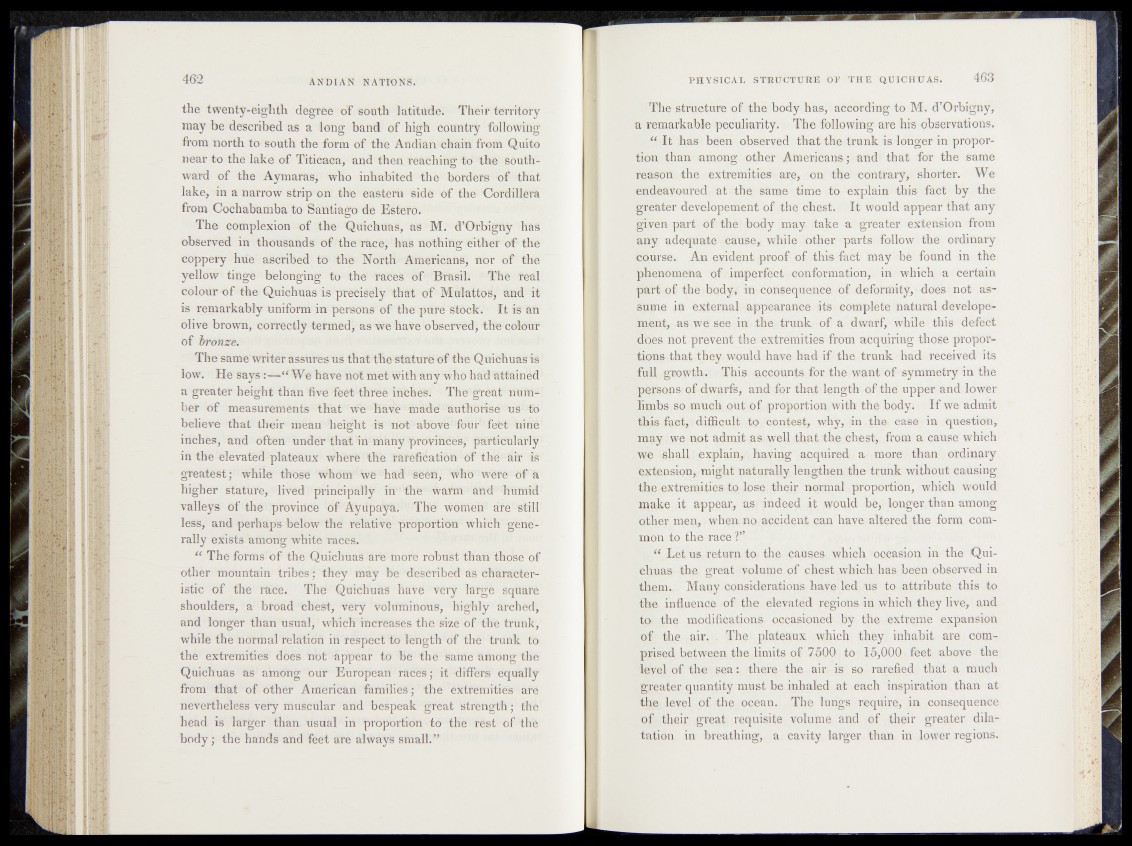
the twenty-mighth digrêe of south latitude. Theif territory
may be described as a long band of high country following
from north to south the form of the Andian ch&iri from Quito
near to the lake oC Titicaca, and then reaching to the south*
ward of the Aymaras> who inhabited the borders of that
lake* in a narrow strip on the eastern side of the Cordillera
from Cochabamba to Santiago de Estero.
The complexion—of the Quichuas, as M. d*Orbigay has
observed in thousands of the race, has nothing either of* thi-
coppery hue ascribed to the North Americana, nor of the
yellow tinge belonging to thé' races Of Brasih The real
colour of the Quiehuas is precisely that of M#ïa4tö^/and it
is remarkably uniform in persons of the pure stock» It is ah
olive brown, correctly termed^ as We have bbseri*ed; tlSScèloar
of bronze.
The same writer assures us that theUtetUrë of the- Qulôhüaëria*
low. He says We hâve not met With any who hud attained
a greater height than five feet three inCh#§ The^èUt num-'
her of measurements that We have made authoi4sbanS to
believe that their mean height is not above fbu r 5 feèt' hi né
inches, and often under that iti' tóhby prorihCëSj'partiOûlâVîÿ
in the elevated plateaux where the mrèfiéation of thb air is
greatest; while those whom1 Wëljhad seén, who w e rè ó fa
higher stature, lived principally in the warm and humid
valleys of the province of Ayupaya: The women are stillless,
and perhaps below thé relative proportion which ^gfene^
rally exists among white races.
“ The forms of the Quichuas are mote robust than those'of
other mountain tribes ; they may be described as characteristic
of the race. The Quichuas have very large square
shoulders, a broad chest, very voluminous, highly arched,
and longer than usual, which increases the size of the trunk,
while the normal relation in respect to length of the trunk to
the extremities does not appear to be the same among the
Quichuas as among our European races ; it differs equally
from that of other American families ; the extremities are
nevertheless very muscular and bespeak great strength ; thé
head is larger than usual in proportion tà the rest of the
body ; the hands and feet are always small/’
$.*Tbe structure of the body has, according to M. d’Ofbigny,
a remarkable peculiarity.; The following are his observations.
“ It has' been observed that the trunk isdonger in propor-
turn than among other Americans; and that for the same
raison the exttemitieSv are, dm the contrary/'shorter. We
endeavoured at the same time to explain this fact by the
greater developement rfftthf It would appear that any
given part of tfie -body may- take a greater - extension horn
any adequate. cause* while other parts follow the ordinary
course. An evident proof of this fact may bis found in the
phenomena Qf. imperftc;t oonfoi’mation, in which a certain
pari of the body, ineontequeneei o f deformity, does not as'*
sume in external appearance its complete natural develope-
nasent, as we-,see in the trunk of a dwarf, while thi s defect
does not prevent the extremities from acquiring those proportions
that they would, have had if the trunk had -received its
full;}growth. This-accounts for the wantbf symmetry in the
persons of dwarfs, and for that lengthof the upper and lower
limbs so much put of proporiion/With the body*.;, If we admit
th^.fdPfefdipcuIt to contest, why, in the onset in question,
may i.wc not admit as well that the chest, from a cause which
we Sfiall explain,, having acquired a more than ordinary
exteo si:on, might naturally lengthen the trunk without causing
thq extremitiesto losetheir normal; proportion, which would
make it appear, as indeed it would be, longer than am e i|
other men, when no accident can have altered the form common
to the race ?”
E ct Let us return to the causes which, »oo^aspn, > the Qui-
chuas the great volume of chest which has been observed in
them., Many considerations havered; us to attribute this to
the influence of the elevated regions in which they live, and
to the modifications occasioned by thet extreme .expansion
of the air. , The plateaux which they,: inhabit; are comprised
between the limits of 7500 - to 15,0QQ > feet above the
leyel of the sea: there the air is* so rarefied that a much
greater quantity must be inhaled at each inspiration than at
the level of the ocean. The lungsrequire, in consequence
of their great requisite volume and of their greater dilatation
in breathing, a cavity larger than in lower regions.